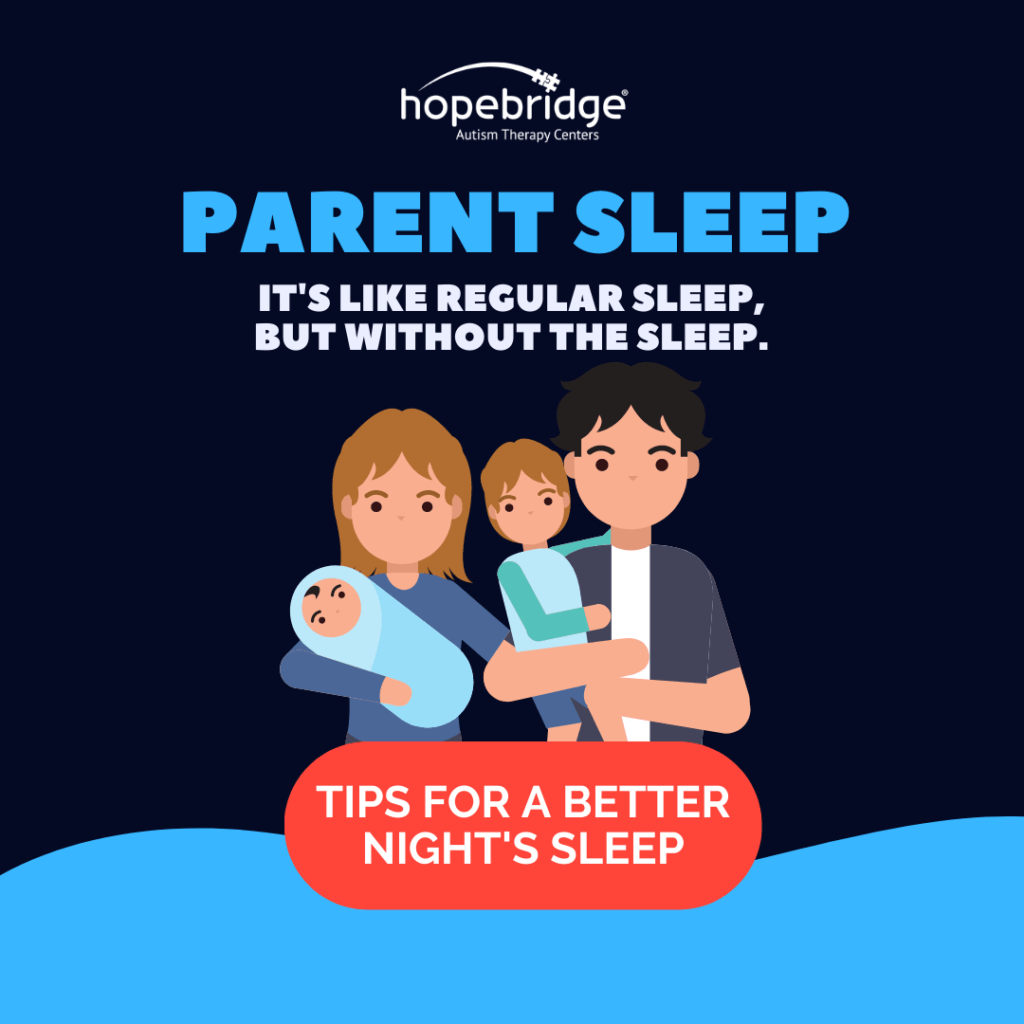Tips for Sleep Challenges in Children with Autism
October 28, 2020
October 28, 2020

“Parent sleep: It’s like regular sleep, but without the sleep.”
This quote may be part of a funny meme floating around social media, but for many, it’s real life. It often seems that once an individual becomes a parent, sleep is never the same. Many of our Hopebridge parents know this all too well. From nighttime awakenings to kids who want to go, go, go – even when it’s bedtime – many autism parents experience added challenges as it relates to sleep.
This can be one of the most draining challenges parents have to cope with, as it not only impacts their children’s behavior and health, but it affects their own daily life. What are caregivers to do if their children with autism spectrum disorder (ASD) – and themselves – are lacking sleep?
To help parents tackle this issue, we connected with one of our own in-house sleep experts, Hopebridge Board Certified Behavior Analyst (BCBA) Rita Donoghue. Rita has extensive experience assisting children and families through autism-related sleep problems at our therapy center in Fishers, Indiana.

If a child isn’t sleeping, no one in the family is sleeping. Working toward a good night’s sleep will improve the quality of life for everyone. Implementing a positive sleep plan may be a lot of work up front, but will pay off in the end. Families who put in the effort early will save themselves years of work and sleep problems for the entire family.
As with many of the challenges the children in our centers face, the first part of our approach is to discover the underlying reasons behind them. While this is sometimes easier said than done, there are certain approaches and tools we use as part of applied behavior analysis (ABA therapy) that can aid us in identifying the root cause.
For sleep in particular, the “Sleep Assessment and Treatment Tool,” by Dr. Gregory P. Hanley is a good starting point, though it requires support from a BCBA to put it into action. This resource is useful because it examines the sleep issue, then the environmental barriers that may play a factor. For instance, is the room too hot? Is there a light that shines through the window? Are there any other sensory-related hurdles that come into play? Assessments like these are important so parents understand what is waking their children.
If the therapy team and family detect an environmental barrier, the next step is to fix it, of course. If temperature is a concern, utilize a fan or adjust the air conditioner or heater. If a furnace is too loud, consider a white noise machine.
One child I worked with would only fall asleep with an open bedroom door, however he would wake any time someone walked down the hallway. To eliminate light and noise, we worked with the family to slowly move the door by one inch each night. Within a week and a half, they were able to close the door and everyone gained a better night’s sleep.
If everything is sound in the “why” area, caregivers and therapists should then look into what the child accesses once they wake. For instance, could they be searching for mom’s attention, snacks, access to TV, etc.?
In these cases, the key is to make the situation really boring when it’s time to sleep. Here are some quick tips for parents struggling with bedtime or night awakenings:

Sleep interventions are not one-size-fits-all. Thankfully, there are many different options available to families working on sleep … we have to get creative!
I worked with one family, for instance, whose daughter slept in the bed with them. In order to help her sleep in her own room, they first moved her bed into the master bedroom. They slowly transitioned the bed into her own bedroom, foot by foot. At one point, it was in the doorway, but it eventually worked!
Above all, look at the sleep challenge your kiddo is experiencing and work with your therapy team to find a solution that works best for you. If one type of intervention doesn’t work for your family dynamic, try another or modify the treatment to meet your needs.
Here are a few intervention examples and tools for common sleep challenges:
For more ideas, Sleep Better! A Guide to Improving Sleep for Children with Special Needs by V. Mark Durand is a great resource for parents and caregivers. The book is very user-friendly and readers do not need to be behavior analysts to understand it.
Life changes, altered schedules and time changes can make sleep even more difficult. To work through these issues, work on a new routine and start the bedtime routine a bit earlier. Whatever your challenges may be, don’t get discouraged. Balancing sleep is tough, even for typically developing children and adults.
If your child has autism and is struggling with sleep, Hopebridge can help. Through ABA therapy, our team can provide guidance on how to reduce the barriers and implement strategies through a program that is personalized for your family. To learn more about Hopebridge’s autism therapy services, please fill out our easy online form to schedule a diagnostic or ABA evaluation at a center near you.
*Informed consent was obtained from the participants in this article. This information should not be captured and reused without express permission from Hopebridge, LLC.
Parenting Resources
March 19, 2021
13 Children’s Books About Autism and Differing Abilities
Parenting Resources
February 10, 2021
5 Skill-Building Valentine’s Day Activities for Kids with Autism
Parenting Resources
September 24, 2019
10 Easy Sensory Activities for Children with Autism